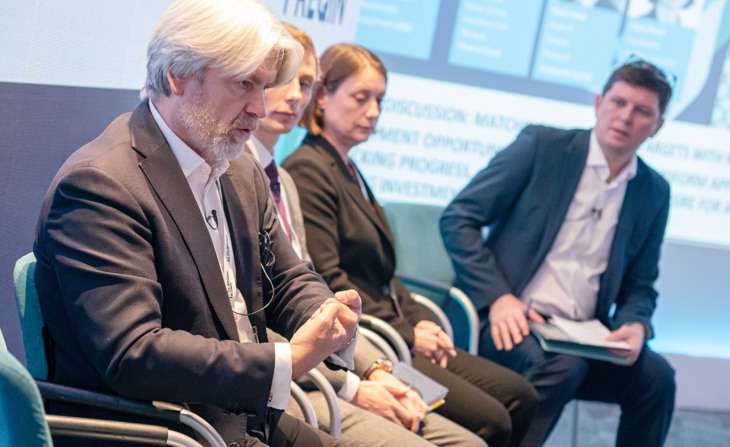
The investment industry “won’t be judged on glossy reports but on how we accurately deploy capital,” said Tim Manuel, Partner, Head of Responsible Investment, AON, as he opened the first panel discussion at the ESG Investment Leader | Europe 2023 event in London on Thursday, 2 November.
Manuel emphasised “turning climate action into proper investment processes”, and said it was more about “being impactful” than “being meaningful”.
The opening discussion was centred on “Matching progression targets with realistic investment opportunities: How to create a uniform approach for tracking progress, and how workable is the desire for accuracy during investment selection?”, with Manuel asking his panel what their organisations were doing to maximise impact.
Regulations and frameworks, if done incorrectly, could box asset owners in and limit assessments, he said. “Do frameworks incentivise the right behaviours?”, Manuel asked.
Clare Wood, Sustainable Portfolio Specialist at Stewart Investors, said her company focused on human development when looking for opportunities. “We use a framework called Project Drawdown to assess the contributions for our portfolio”, she said.
Her company focused on these core themes as a way to quality control the companies in which they invested and – and Wood emphasised that, in her view, “it's about a race to zero, not net zero by 2050”.
“It's about a race to zero, not net zero by 2050.”
She added that because her organisation invested widely across Asia – where disclosures are very general – the company focused on direct engagement with companies, which presented unique challenges.
Ryan Allison, Senior Climate Investment Risk Manager, Phoenix Group, said that his organisation’s belief was that the net zero transition was a “fiduciary duty to our customers”. To this aim, he said, they were working toward interim decarbonisation targets of 25% emission reduction by 2025 and 50% by 2030.
Much of the debate focused on the effect the path to net zero would have on the economy and portfolio allocation decisions. Mark Lewis, Head of Climate Research at Andurand Capital, a commodity-focused hedge fund, said that, ideally, the goal was to “make money off of investing in the energy transition”.
He added that he believed there was an “intrinsic value” to be seized, due to the fact that renewable energy was a deflationary market whilst fossil fuels were inherently exhaustive and inflationary. “In economies of scale, it will be impossible for fossil fuels to stay in the game over time,” he said. “They become more expensive over time.
“In economies of scale, it will be impossible for fossil fuels
to stay in the game over time.”
Lewis honed in on the materials that would be necessary to achieve net zero goals – for example, cobalt and other minerals for solar panels, batteries, and electric vehicle parts. “The cost of renewable energy is in infrastructure,” he said. “It’s mainly a question of building that infrastructure.”
He also criticised the media representation of net-zero as a series of short-term goals, singling out recent discussions by UK Prime Minister Rishi Sunak, and noted that there was a significant distinction between carbon allowances and voluntary offsets. The former could remove carbon from the markets, which meant creating an “economic incentive to look for alternatives”.
Allison emphasised the ‘engagement versus divestment’ debate, noting that his organisation preferred to engage with carbon-emitting companies instead of “losing a seat at the table to change behaviour”. He added that to motivate behavioural change, they set “milestones” for their partner. “If we [then] don’t see change we disengage,” he said. “But we need to develop forward-looking metrics to better identify transition assets.”
The further question – of how organisations define and monitor these assets when no singular measurement offers the perfect data – came to the fore. Panellists said that a “suite of metrics” was needed to monitor investment around the energy transition, such as those in batter companies, for example.
“We need to develop forward-looking metrics to
better identify transition assets.”
“We need to electrify everything wherever we can,” said Lewis. “There’s a mismatch between the way renewable energy is talked about and the actual economic reality,” he added, referring to frequent conversation bemoaning its cost.
On the whole, the panellists were resolute in their defence of a long-term mindset being the only effective way to achieve portfolio goals around net-zero. Wood, in particular, emphasised that her organisation does not make investments with less than a ten-year timeframe in mind.
However, the ultimate proof of efficacy in this area is whether net-zero transition goals come to fruition on time – or not.